Comparative Analysis: Social Media vs Traditional Media Recruitment
VerifiedAdded on 2023/06/09
|7
|1655
|135
Report
AI Summary
This report provides a detailed comparison between social media and traditional media recruitment methods. It begins by defining social media recruitment and traditional recruitment, highlighting the increasing use of social media in modern recruitment processes. The research aims to identify the differences in candidate assessment techniques between the two approaches, with objectives including understanding the concepts, analyzing the differences, and examining the tools used in each method. The significance of the research lies in its potential to improve recruitment effectiveness and organizational performance. The methodology employs a positivism research philosophy, a deductive approach, and quantitative methods, utilizing both primary data collected through questionnaires and secondary data from literature reviews. The report outlines the structure of the research, including chapters on introduction, literature review, research methodology, findings, conclusion, and recommendations. It also touches upon emerging trends in social media recruitment, such as live broadcasting and the use of data analytics to enhance hiring decisions. This assignment is available on Desklib, a platform offering a wide array of study tools and resources for students.
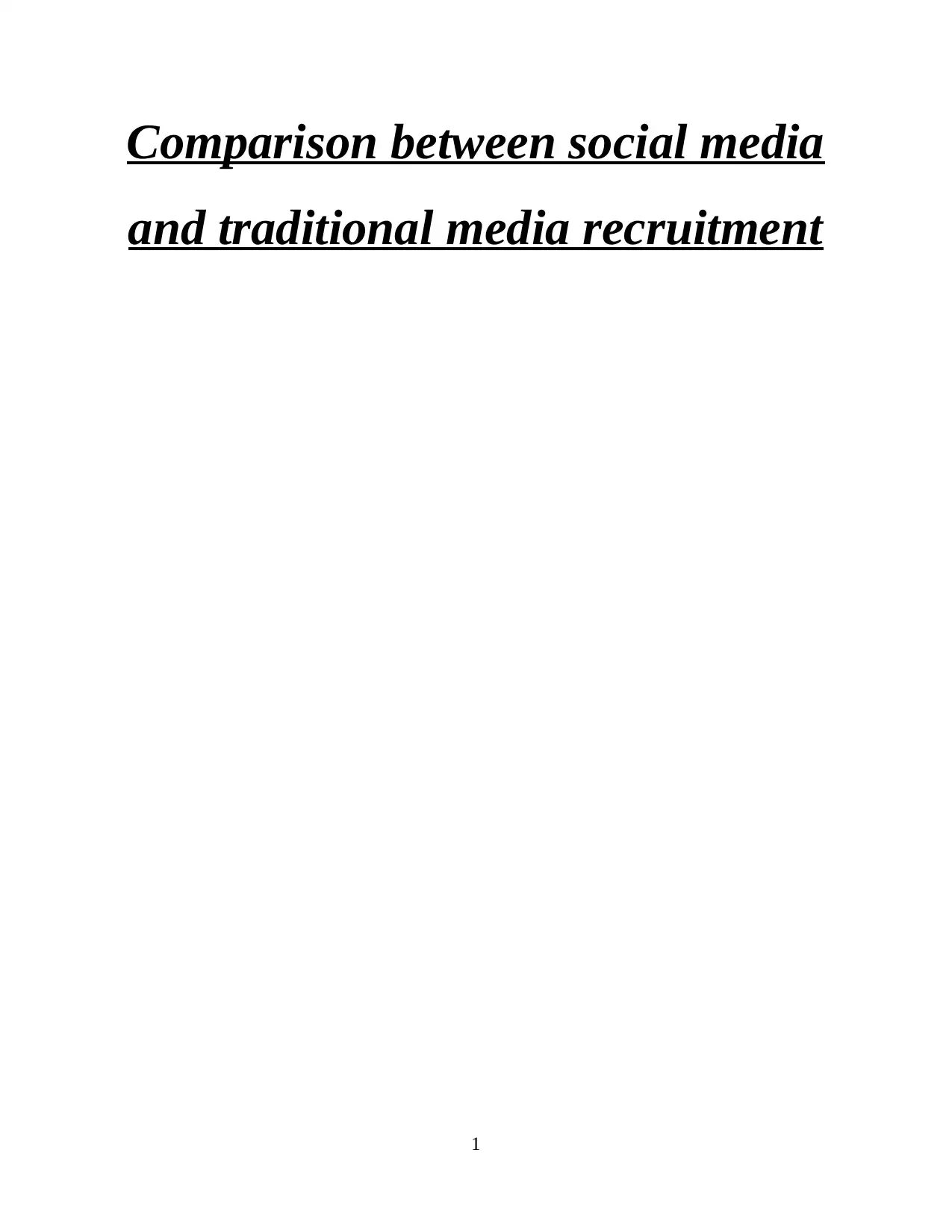
Comparison between social media
and traditional media recruitment
1
and traditional media recruitment
1
Paraphrase This Document
Need a fresh take? Get an instant paraphrase of this document with our AI Paraphraser
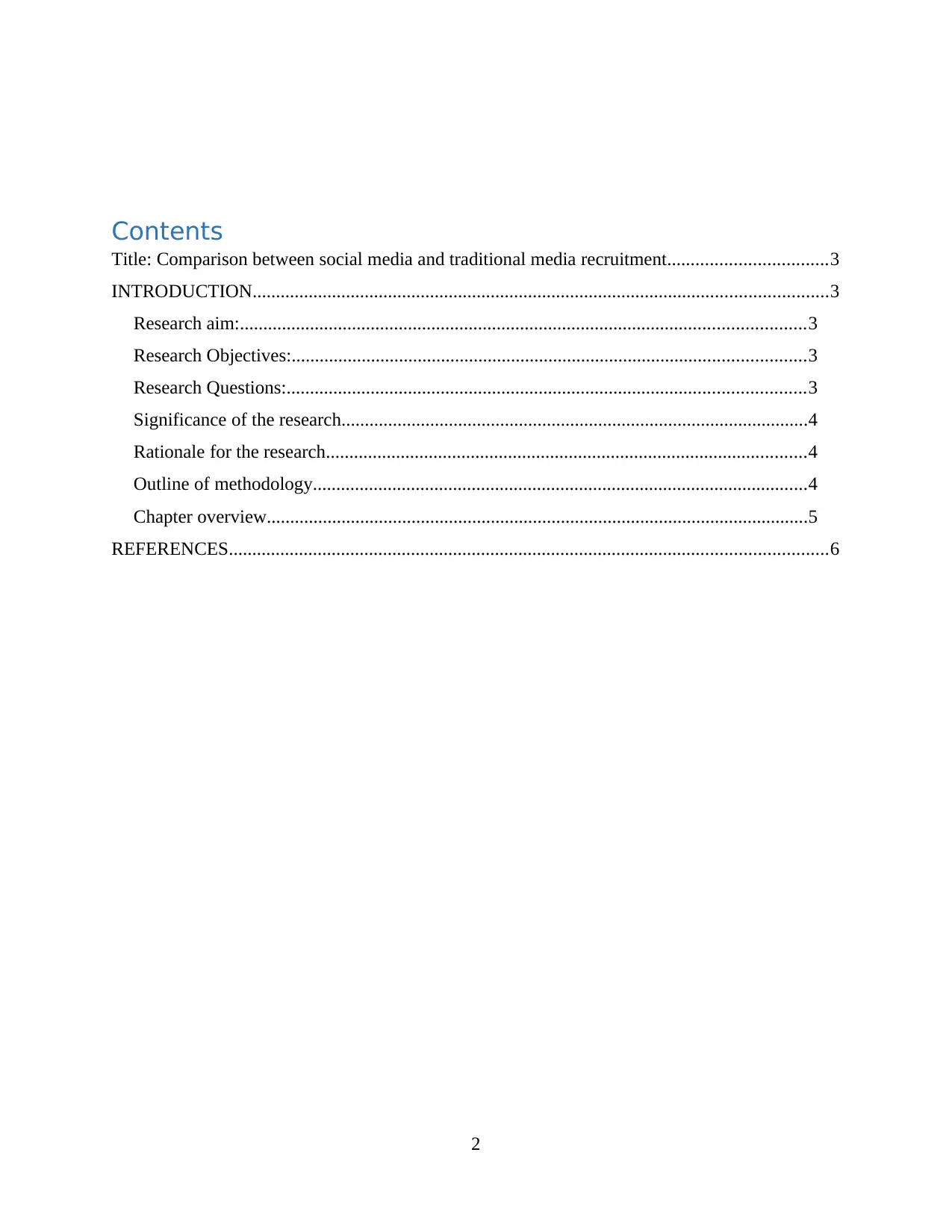
Contents
Title: Comparison between social media and traditional media recruitment..................................3
INTRODUCTION...........................................................................................................................3
Research aim:.........................................................................................................................3
Research Objectives:..............................................................................................................3
Research Questions:...............................................................................................................3
Significance of the research....................................................................................................4
Rationale for the research.......................................................................................................4
Outline of methodology..........................................................................................................4
Chapter overview....................................................................................................................5
REFERENCES................................................................................................................................6
2
Title: Comparison between social media and traditional media recruitment..................................3
INTRODUCTION...........................................................................................................................3
Research aim:.........................................................................................................................3
Research Objectives:..............................................................................................................3
Research Questions:...............................................................................................................3
Significance of the research....................................................................................................4
Rationale for the research.......................................................................................................4
Outline of methodology..........................................................................................................4
Chapter overview....................................................................................................................5
REFERENCES................................................................................................................................6
2
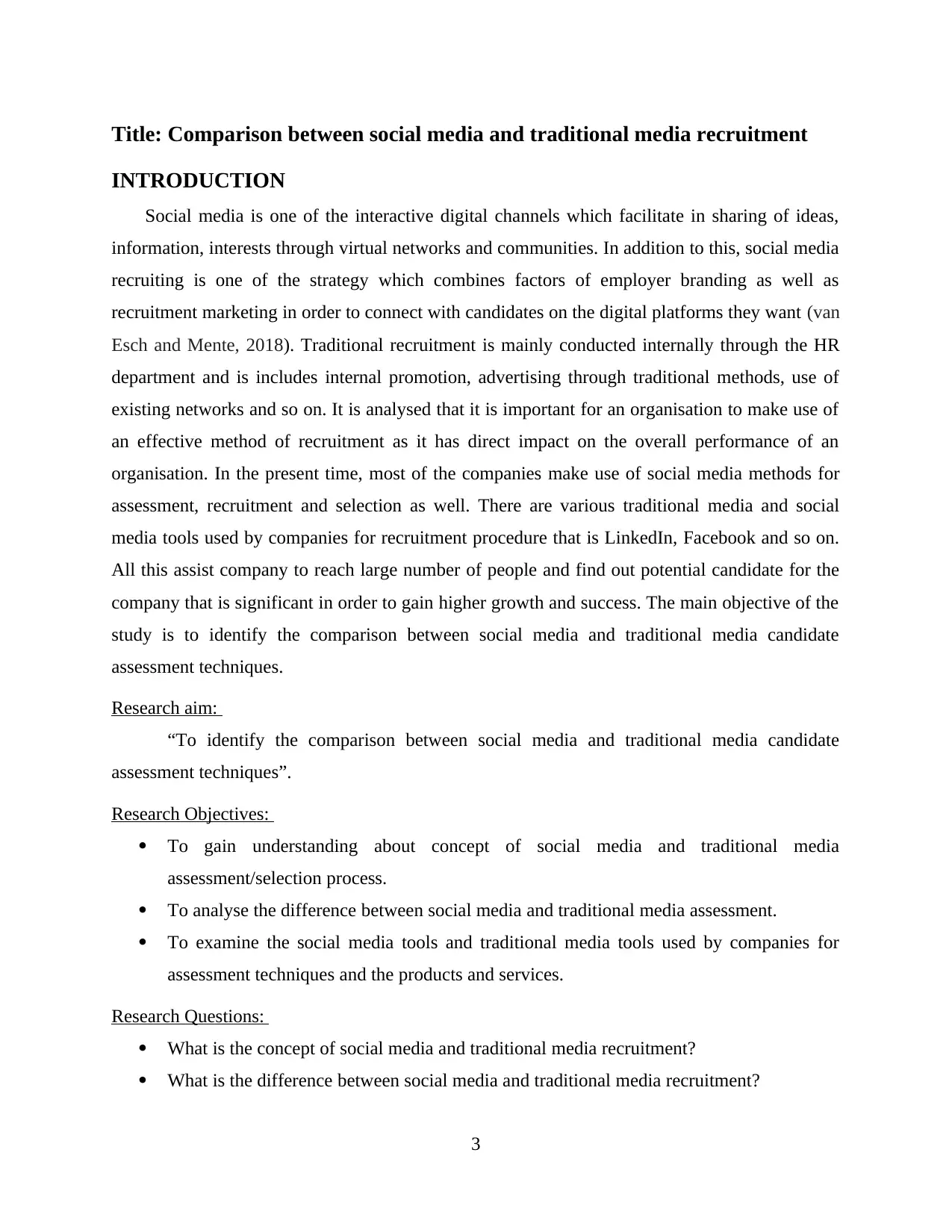
Title: Comparison between social media and traditional media recruitment
INTRODUCTION
Social media is one of the interactive digital channels which facilitate in sharing of ideas,
information, interests through virtual networks and communities. In addition to this, social media
recruiting is one of the strategy which combines factors of employer branding as well as
recruitment marketing in order to connect with candidates on the digital platforms they want (van
Esch and Mente, 2018). Traditional recruitment is mainly conducted internally through the HR
department and is includes internal promotion, advertising through traditional methods, use of
existing networks and so on. It is analysed that it is important for an organisation to make use of
an effective method of recruitment as it has direct impact on the overall performance of an
organisation. In the present time, most of the companies make use of social media methods for
assessment, recruitment and selection as well. There are various traditional media and social
media tools used by companies for recruitment procedure that is LinkedIn, Facebook and so on.
All this assist company to reach large number of people and find out potential candidate for the
company that is significant in order to gain higher growth and success. The main objective of the
study is to identify the comparison between social media and traditional media candidate
assessment techniques.
Research aim:
“To identify the comparison between social media and traditional media candidate
assessment techniques”.
Research Objectives:
To gain understanding about concept of social media and traditional media
assessment/selection process.
To analyse the difference between social media and traditional media assessment.
To examine the social media tools and traditional media tools used by companies for
assessment techniques and the products and services.
Research Questions:
What is the concept of social media and traditional media recruitment?
What is the difference between social media and traditional media recruitment?
3
INTRODUCTION
Social media is one of the interactive digital channels which facilitate in sharing of ideas,
information, interests through virtual networks and communities. In addition to this, social media
recruiting is one of the strategy which combines factors of employer branding as well as
recruitment marketing in order to connect with candidates on the digital platforms they want (van
Esch and Mente, 2018). Traditional recruitment is mainly conducted internally through the HR
department and is includes internal promotion, advertising through traditional methods, use of
existing networks and so on. It is analysed that it is important for an organisation to make use of
an effective method of recruitment as it has direct impact on the overall performance of an
organisation. In the present time, most of the companies make use of social media methods for
assessment, recruitment and selection as well. There are various traditional media and social
media tools used by companies for recruitment procedure that is LinkedIn, Facebook and so on.
All this assist company to reach large number of people and find out potential candidate for the
company that is significant in order to gain higher growth and success. The main objective of the
study is to identify the comparison between social media and traditional media candidate
assessment techniques.
Research aim:
“To identify the comparison between social media and traditional media candidate
assessment techniques”.
Research Objectives:
To gain understanding about concept of social media and traditional media
assessment/selection process.
To analyse the difference between social media and traditional media assessment.
To examine the social media tools and traditional media tools used by companies for
assessment techniques and the products and services.
Research Questions:
What is the concept of social media and traditional media recruitment?
What is the difference between social media and traditional media recruitment?
3
⊘ This is a preview!⊘
Do you want full access?
Subscribe today to unlock all pages.

Trusted by 1+ million students worldwide
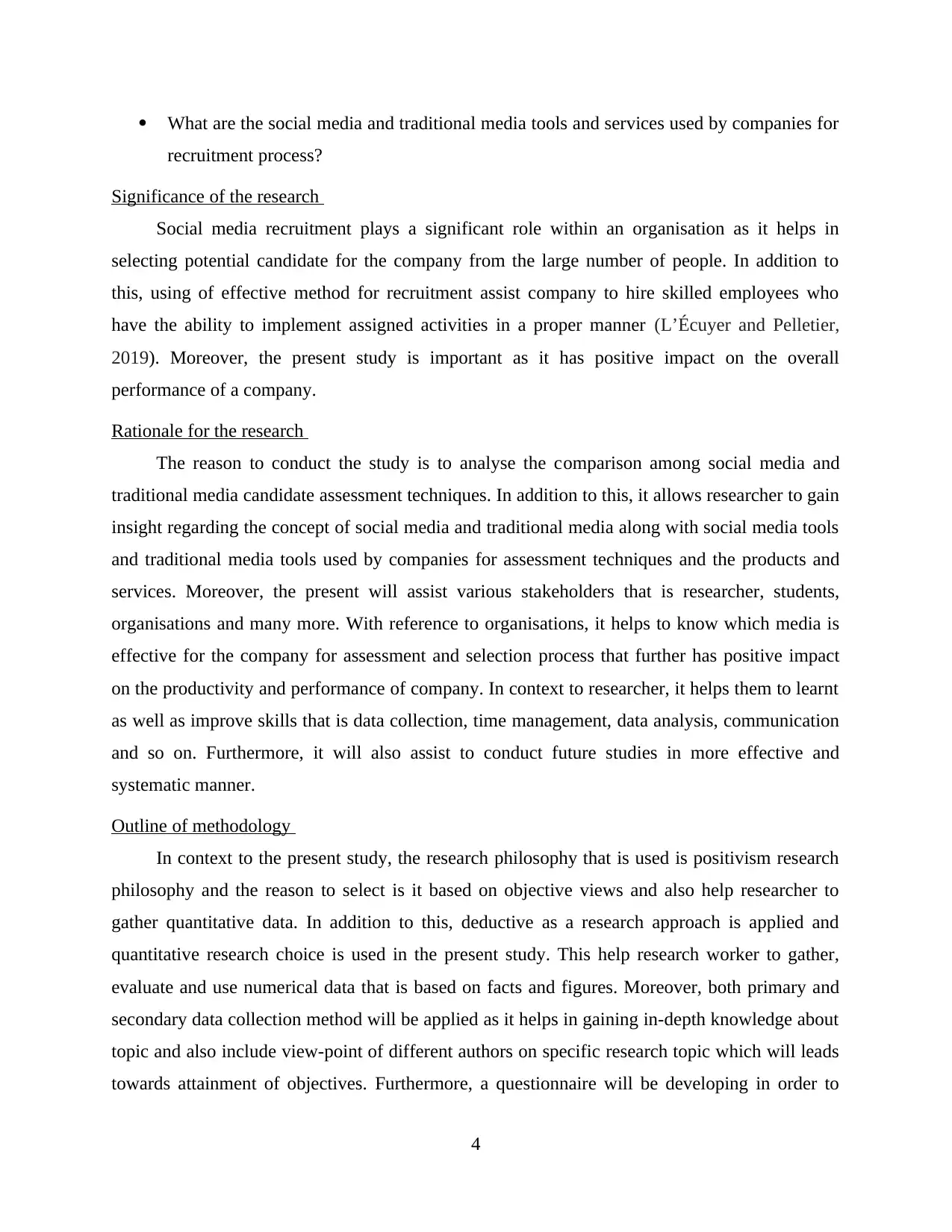
What are the social media and traditional media tools and services used by companies for
recruitment process?
Significance of the research
Social media recruitment plays a significant role within an organisation as it helps in
selecting potential candidate for the company from the large number of people. In addition to
this, using of effective method for recruitment assist company to hire skilled employees who
have the ability to implement assigned activities in a proper manner (L’Écuyer and Pelletier,
2019). Moreover, the present study is important as it has positive impact on the overall
performance of a company.
Rationale for the research
The reason to conduct the study is to analyse the comparison among social media and
traditional media candidate assessment techniques. In addition to this, it allows researcher to gain
insight regarding the concept of social media and traditional media along with social media tools
and traditional media tools used by companies for assessment techniques and the products and
services. Moreover, the present will assist various stakeholders that is researcher, students,
organisations and many more. With reference to organisations, it helps to know which media is
effective for the company for assessment and selection process that further has positive impact
on the productivity and performance of company. In context to researcher, it helps them to learnt
as well as improve skills that is data collection, time management, data analysis, communication
and so on. Furthermore, it will also assist to conduct future studies in more effective and
systematic manner.
Outline of methodology
In context to the present study, the research philosophy that is used is positivism research
philosophy and the reason to select is it based on objective views and also help researcher to
gather quantitative data. In addition to this, deductive as a research approach is applied and
quantitative research choice is used in the present study. This help research worker to gather,
evaluate and use numerical data that is based on facts and figures. Moreover, both primary and
secondary data collection method will be applied as it helps in gaining in-depth knowledge about
topic and also include view-point of different authors on specific research topic which will leads
towards attainment of objectives. Furthermore, a questionnaire will be developing in order to
4
recruitment process?
Significance of the research
Social media recruitment plays a significant role within an organisation as it helps in
selecting potential candidate for the company from the large number of people. In addition to
this, using of effective method for recruitment assist company to hire skilled employees who
have the ability to implement assigned activities in a proper manner (L’Écuyer and Pelletier,
2019). Moreover, the present study is important as it has positive impact on the overall
performance of a company.
Rationale for the research
The reason to conduct the study is to analyse the comparison among social media and
traditional media candidate assessment techniques. In addition to this, it allows researcher to gain
insight regarding the concept of social media and traditional media along with social media tools
and traditional media tools used by companies for assessment techniques and the products and
services. Moreover, the present will assist various stakeholders that is researcher, students,
organisations and many more. With reference to organisations, it helps to know which media is
effective for the company for assessment and selection process that further has positive impact
on the productivity and performance of company. In context to researcher, it helps them to learnt
as well as improve skills that is data collection, time management, data analysis, communication
and so on. Furthermore, it will also assist to conduct future studies in more effective and
systematic manner.
Outline of methodology
In context to the present study, the research philosophy that is used is positivism research
philosophy and the reason to select is it based on objective views and also help researcher to
gather quantitative data. In addition to this, deductive as a research approach is applied and
quantitative research choice is used in the present study. This help research worker to gather,
evaluate and use numerical data that is based on facts and figures. Moreover, both primary and
secondary data collection method will be applied as it helps in gaining in-depth knowledge about
topic and also include view-point of different authors on specific research topic which will leads
towards attainment of objectives. Furthermore, a questionnaire will be developing in order to
4
Paraphrase This Document
Need a fresh take? Get an instant paraphrase of this document with our AI Paraphraser
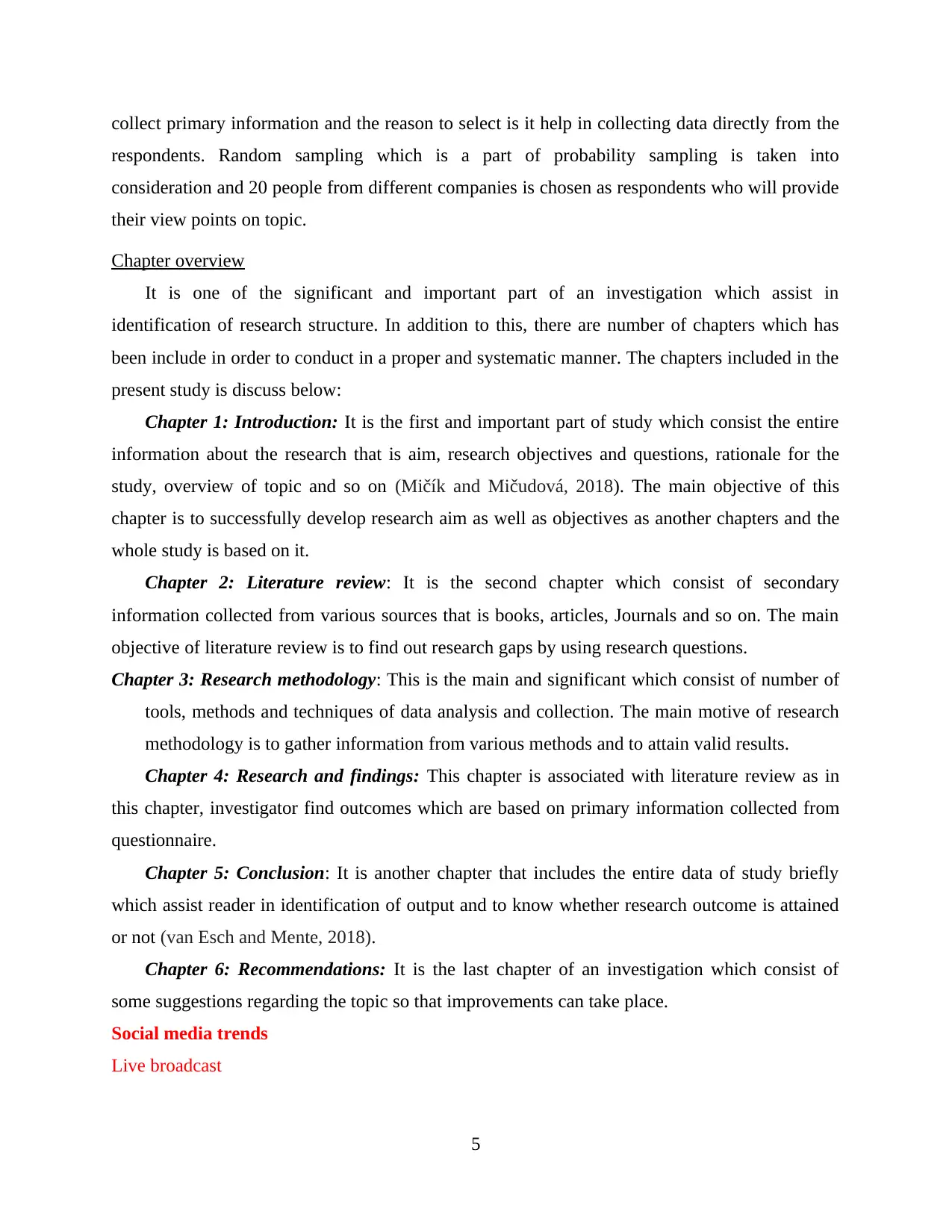
collect primary information and the reason to select is it help in collecting data directly from the
respondents. Random sampling which is a part of probability sampling is taken into
consideration and 20 people from different companies is chosen as respondents who will provide
their view points on topic.
Chapter overview
It is one of the significant and important part of an investigation which assist in
identification of research structure. In addition to this, there are number of chapters which has
been include in order to conduct in a proper and systematic manner. The chapters included in the
present study is discuss below:
Chapter 1: Introduction: It is the first and important part of study which consist the entire
information about the research that is aim, research objectives and questions, rationale for the
study, overview of topic and so on (Mičík and Mičudová, 2018). The main objective of this
chapter is to successfully develop research aim as well as objectives as another chapters and the
whole study is based on it.
Chapter 2: Literature review: It is the second chapter which consist of secondary
information collected from various sources that is books, articles, Journals and so on. The main
objective of literature review is to find out research gaps by using research questions.
Chapter 3: Research methodology: This is the main and significant which consist of number of
tools, methods and techniques of data analysis and collection. The main motive of research
methodology is to gather information from various methods and to attain valid results.
Chapter 4: Research and findings: This chapter is associated with literature review as in
this chapter, investigator find outcomes which are based on primary information collected from
questionnaire.
Chapter 5: Conclusion: It is another chapter that includes the entire data of study briefly
which assist reader in identification of output and to know whether research outcome is attained
or not (van Esch and Mente, 2018).
Chapter 6: Recommendations: It is the last chapter of an investigation which consist of
some suggestions regarding the topic so that improvements can take place.
Social media trends
Live broadcast
5
respondents. Random sampling which is a part of probability sampling is taken into
consideration and 20 people from different companies is chosen as respondents who will provide
their view points on topic.
Chapter overview
It is one of the significant and important part of an investigation which assist in
identification of research structure. In addition to this, there are number of chapters which has
been include in order to conduct in a proper and systematic manner. The chapters included in the
present study is discuss below:
Chapter 1: Introduction: It is the first and important part of study which consist the entire
information about the research that is aim, research objectives and questions, rationale for the
study, overview of topic and so on (Mičík and Mičudová, 2018). The main objective of this
chapter is to successfully develop research aim as well as objectives as another chapters and the
whole study is based on it.
Chapter 2: Literature review: It is the second chapter which consist of secondary
information collected from various sources that is books, articles, Journals and so on. The main
objective of literature review is to find out research gaps by using research questions.
Chapter 3: Research methodology: This is the main and significant which consist of number of
tools, methods and techniques of data analysis and collection. The main motive of research
methodology is to gather information from various methods and to attain valid results.
Chapter 4: Research and findings: This chapter is associated with literature review as in
this chapter, investigator find outcomes which are based on primary information collected from
questionnaire.
Chapter 5: Conclusion: It is another chapter that includes the entire data of study briefly
which assist reader in identification of output and to know whether research outcome is attained
or not (van Esch and Mente, 2018).
Chapter 6: Recommendations: It is the last chapter of an investigation which consist of
some suggestions regarding the topic so that improvements can take place.
Social media trends
Live broadcast
5
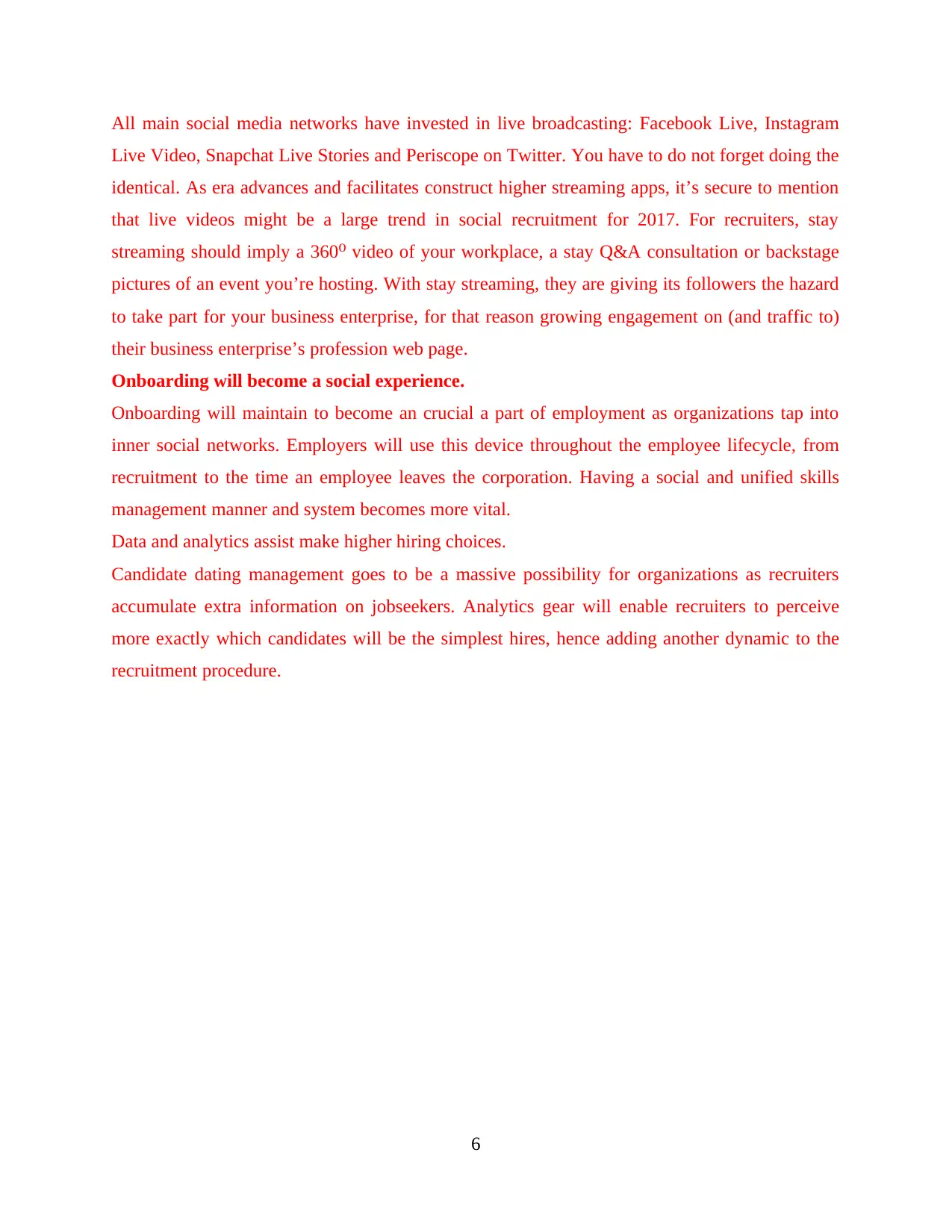
All main social media networks have invested in live broadcasting: Facebook Live, Instagram
Live Video, Snapchat Live Stories and Periscope on Twitter. You have to do not forget doing the
identical. As era advances and facilitates construct higher streaming apps, it’s secure to mention
that live videos might be a large trend in social recruitment for 2017. For recruiters, stay
streaming should imply a 360 video of your workplace, a stay Q&A consultation or backstage⁰
pictures of an event you’re hosting. With stay streaming, they are giving its followers the hazard
to take part for your business enterprise, for that reason growing engagement on (and traffic to)
their business enterprise’s profession web page.
Onboarding will become a social experience.
Onboarding will maintain to become an crucial a part of employment as organizations tap into
inner social networks. Employers will use this device throughout the employee lifecycle, from
recruitment to the time an employee leaves the corporation. Having a social and unified skills
management manner and system becomes more vital.
Data and analytics assist make higher hiring choices.
Candidate dating management goes to be a massive possibility for organizations as recruiters
accumulate extra information on jobseekers. Analytics gear will enable recruiters to perceive
more exactly which candidates will be the simplest hires, hence adding another dynamic to the
recruitment procedure.
6
Live Video, Snapchat Live Stories and Periscope on Twitter. You have to do not forget doing the
identical. As era advances and facilitates construct higher streaming apps, it’s secure to mention
that live videos might be a large trend in social recruitment for 2017. For recruiters, stay
streaming should imply a 360 video of your workplace, a stay Q&A consultation or backstage⁰
pictures of an event you’re hosting. With stay streaming, they are giving its followers the hazard
to take part for your business enterprise, for that reason growing engagement on (and traffic to)
their business enterprise’s profession web page.
Onboarding will become a social experience.
Onboarding will maintain to become an crucial a part of employment as organizations tap into
inner social networks. Employers will use this device throughout the employee lifecycle, from
recruitment to the time an employee leaves the corporation. Having a social and unified skills
management manner and system becomes more vital.
Data and analytics assist make higher hiring choices.
Candidate dating management goes to be a massive possibility for organizations as recruiters
accumulate extra information on jobseekers. Analytics gear will enable recruiters to perceive
more exactly which candidates will be the simplest hires, hence adding another dynamic to the
recruitment procedure.
6
⊘ This is a preview!⊘
Do you want full access?
Subscribe today to unlock all pages.

Trusted by 1+ million students worldwide
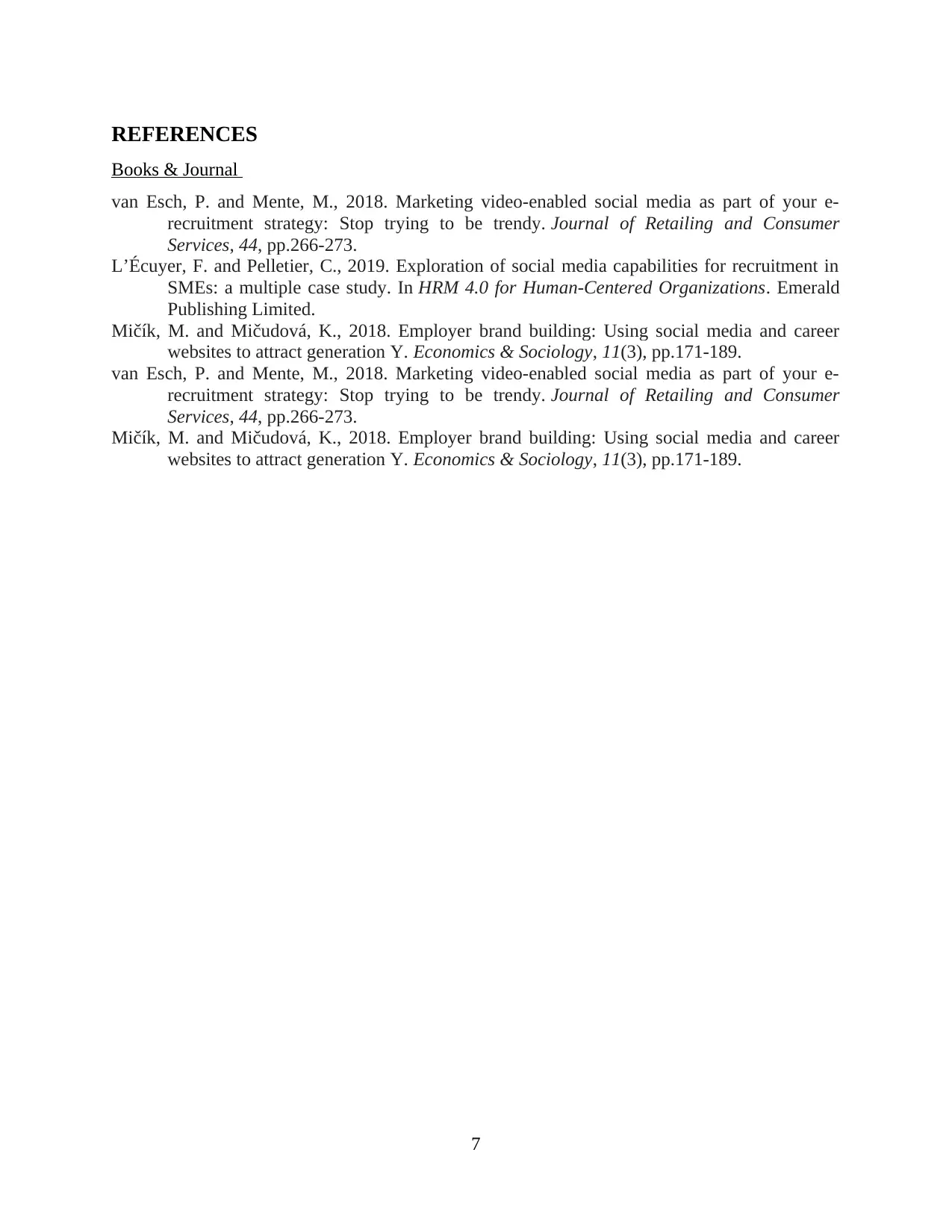
REFERENCES
Books & Journal
van Esch, P. and Mente, M., 2018. Marketing video-enabled social media as part of your e-
recruitment strategy: Stop trying to be trendy. Journal of Retailing and Consumer
Services, 44, pp.266-273.
L’Écuyer, F. and Pelletier, C., 2019. Exploration of social media capabilities for recruitment in
SMEs: a multiple case study. In HRM 4.0 for Human-Centered Organizations. Emerald
Publishing Limited.
Mičík, M. and Mičudová, K., 2018. Employer brand building: Using social media and career
websites to attract generation Y. Economics & Sociology, 11(3), pp.171-189.
van Esch, P. and Mente, M., 2018. Marketing video-enabled social media as part of your e-
recruitment strategy: Stop trying to be trendy. Journal of Retailing and Consumer
Services, 44, pp.266-273.
Mičík, M. and Mičudová, K., 2018. Employer brand building: Using social media and career
websites to attract generation Y. Economics & Sociology, 11(3), pp.171-189.
7
Books & Journal
van Esch, P. and Mente, M., 2018. Marketing video-enabled social media as part of your e-
recruitment strategy: Stop trying to be trendy. Journal of Retailing and Consumer
Services, 44, pp.266-273.
L’Écuyer, F. and Pelletier, C., 2019. Exploration of social media capabilities for recruitment in
SMEs: a multiple case study. In HRM 4.0 for Human-Centered Organizations. Emerald
Publishing Limited.
Mičík, M. and Mičudová, K., 2018. Employer brand building: Using social media and career
websites to attract generation Y. Economics & Sociology, 11(3), pp.171-189.
van Esch, P. and Mente, M., 2018. Marketing video-enabled social media as part of your e-
recruitment strategy: Stop trying to be trendy. Journal of Retailing and Consumer
Services, 44, pp.266-273.
Mičík, M. and Mičudová, K., 2018. Employer brand building: Using social media and career
websites to attract generation Y. Economics & Sociology, 11(3), pp.171-189.
7
1 out of 7
Related Documents
Your All-in-One AI-Powered Toolkit for Academic Success.
+13062052269
info@desklib.com
Available 24*7 on WhatsApp / Email
![[object Object]](/_next/static/media/star-bottom.7253800d.svg)
Unlock your academic potential
Copyright © 2020–2025 A2Z Services. All Rights Reserved. Developed and managed by ZUCOL.




